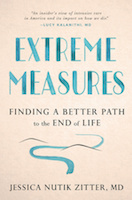
I first met Stephanie in the Intensive Care Unit. She was an urgent admission — in shock, her blood pressure was almost unmeasurable. Over the previous month, the rate of cancerous fluid building up around her lungs had increased. She had used the permanent drainage tube in her chest wall more frequently to manage her shortness of breath. But in the process, she had made her blood pressure dangerously low. She was unconscious and mumbling incoherently. Her kidneys and liver weren’t getting enough blood and were effectively dying. We worked quickly. And we were lucky enough to be able to rehydrate her before her organs became permanently damaged. Slowly, she woke up again. We had saved her.
Stephanie was a 60-year-old wife, mother and grandmother. She loved life. Wine tastings, gardening, spending time with her family — this didn’t stop when she was diagnosed. When she had learned that the cancer had spread to the other lung and brain, she took a deep breath and went back into the ring to fight. She signed up for more chemotherapy. If she worked hard, she thought, she could beat it.
I wanted to celebrate with Stephanie and her family — she was no longer in critical condition — but I couldn’t. Our “fix” wasn’t going to change the fact that her cancer would continue to worsen. And fast. More chemotherapy would not save this woman. I had to tell her the truth.
When I walked into the room, Stephanie’s daughter Becky was giving her a massage. I thought of a manager preparing his boxer to return to the ring. “We’re ready to get back in there and fight,” Becky told me. “Bring on the chemotherapy.” Stephanie looked tired, but nodded. I took a deep breath and sat on the side of the bed.
I explained that it was only a matter of time before Stephanie’s organs failed again. The next time, she probably wouldn’t be so lucky. The corners of Stephanie’s mouth pointed down, like two arrows, and I wasn’t sure if she was getting ready to cry or yell. “Please leave,” Becky said.
I had done the right thing, but nonetheless I felt ashamed. I wasn’t the doctor they had been hoping for. I wasn’t their hero.
We all know we will die. But somehow none of us believes it. This is a serious obstacle to dying well.
To start to find a way to experience a better end, we need to reflect on our own deaths and begin the process of accepting our mortality. This may happen through meditation, writing or conversations. Of course we should have hope if illness strikes us, but hope for perpetual life is blind. As we age or grow ill, the goal may switch from hope for longer life to hope for more attainable goals like healing relationships, living pain-free and enjoying a glass of Cabernet.
Simultaneously, we must prepare for this final stage of life. We must consider our preferences and values and shared them with our loved ones. Stephanie cared about being at home, with her family. What is most important to you? What would be most important to your loved ones? One day you might be called on to represent them. This conversation should happen repeatedly over the years, through the various stages of life and changes in health.
We must all — doctor, nurse, patient and family — also remember that these decisions require the collaboration of a whole team. The doctor is indeed the expert on the disease, but the patient is the expert on the patient. If you feel that you are not being included in decision-making for yourself or a loved one, or you don’t feel the team is communicating well, request a palliative care consultation, which brings communication expertise into the picture.
Two days later, I went upstairs to check on Stephanie and her family. I was no longer responsible for the case. Still, I worried that I had upset them, and I wanted to check in. I was dreading it.
But when I reached the room, there was Stephanie sitting in a wheelchair, smiling. She was going home that day. The family had had some time to absorb the news, and then they had changed the course of care. They had met with a hospice service. No more hospitals. No more chemotherapy.
Stephanie enjoyed the last two months of life with the support of hospice, her family and several bottles of good wine. Her funeral, which I attended, was replete with wonderful stories and not an ounce of regret. She died in my arms, Becky said, and it was as loving and peaceful a death as you could imagine.
Stephanie’s last couple of months might have looked very different. Like many of my patients, she could have died attached to machines. She could have been isolated from her family instead of in a cozy bed in the middle of the living room. And rather than the taste of wine and crackers, she could have had breathing and feeding tubes filling her mouth.
I’ve seen so many patients, so many lives, so many deaths. Far too few have the opportunity to live the life they would choose all the way through to the end. I believe deaths like Stephanie’s should be the rule, rather than the exception. And that is going to take some work from all of us — in the form of reflection, preparation and collaboration.
When it comes to death and dying, the answer is found in honest communication and human connection rather than technology and protocols. We’ve achieved amazing things in modern medicine. Our tools can serve to bring the dying back to life. But too often they take life away from the dying.
Dr. Zitter is an ICU and palliative care specialist and the author of Extreme Measures: Finding a Better Path to the End of Life; she was featured in the Oscar-nominated Netflix documentary Extremis.

Adapted from Extreme Measures: Finding a Better Path to the End of Life by Jessica Nutik Zitter, MD, published on February 21, 2017 by Avery, an imprint of Penguin Publishing Group, a division of Penguin Random House, LLC. Copyright © 2017 by Jessica Nutik Zitter.
More Must-Reads from TIME
- Why Trump’s Message Worked on Latino Men
- What Trump’s Win Could Mean for Housing
- The 100 Must-Read Books of 2024
- Sleep Doctors Share the 1 Tip That’s Changed Their Lives
- Column: Let’s Bring Back Romance
- What It’s Like to Have Long COVID As a Kid
- FX’s Say Nothing Is the Must-Watch Political Thriller of 2024
- Merle Bombardieri Is Helping People Make the Baby Decision
Contact us at letters@time.com